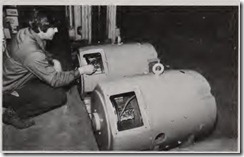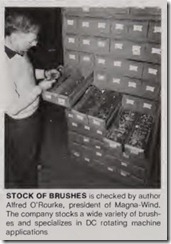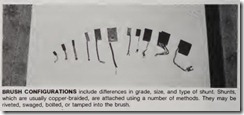Selecting brushes for motors and generators
By ALFRED O’ROURKE, President, Magna-Wind, Inc.
Electrical-Mechanical Sales & Service, Wallingford, CT
RELIABLE performance of brushed-equipped motors and genera tors depends on careful choice of the proper brush for the application. Numerous characteristics dictate which brush will be most effective in any given situation. The most-impor tant characteristics are: specific resist ance, friction coefficient, current-car rying capacity, maximum operating speed, and abrasiveness.
Specific resistance. Unless other wise specified, specific resistance is the resistivity of the brush material in ohm-inches (ohms/in. cube) when measured in the length direction of the slab. (Resistance in the direction of width or thickness may be considerably different.) Knowledge of the specific resistance of a brush will help when compared to other brush characteris tics during evaluation of-a brush application.
Friction coefficient. This is defined as the ratio of the force on a surface to the force required to slide another surface over it. In the case of a brush, the friction coefficient is determined from tests made on a 10-in.-dia slotted copper commutator with a peripheral speed of 3000 ft/per min. A brush pressure of 4 lbs/in2 on brushes having a cross section of 1 sq in. is used for these measurements. Brush friction is influenced by many factors, including brush temperature, brush pressure, current, atmospheric conditions, me chanical conditions, ring or commuta tor materials, surface films, and speed.
Brush friction increases drastically when brushes operate at temperatures lower than about 60°C and above approximately 100 to 120°C. The resulting high brush friction often causes brush chatter and chipping. The temperature extremes are usually the result of improper electrical loading either high or low current densities .
Thus, it is important to operate brushes at the recommended current density, usually between 35 to 70 A per square In.
tion is wasted power. One manufactur er broadly classifies brushes as fol lows:
ROTATING MACHINES Include DC motors and generators as well as motors furnished with slip rings. David Kulak, plant superinten dent for Magna-Wind, Inc., inspects brushes on reconditioned equipment.
Current-carrying capacity. The actual current-carrying capacity of a brush is widely influenced by operating conditions such as type of ventilation, continuous or intermittent duty, speed, and other factors. Most manufacturers publish tables recommending am peres/sq in. to be carried by a specific brush. However, this value varies in accordance with the application. Ca pacity can vary from about 40 A/sq in. for carbon brushes to 180 A/sq in. for metal-graphite brushes.
The current-carrying capacity of a brush depends on the operating tem perature. On well-ventilated machines having small brushes with large sur face area in proportion to their volume, and where brushes cover only a small percentage of the commutator or ring surface, conventional current densities can usually be doubled without serious ly jeopardizing the performance. On the other hand, increasing the current density without making provisions for maintaining a low brush temperature may reduce the brush life many times. Maximum operating speed. The highest peripheral speed in feet per minute recommended for the collector or commutator on which the brush is to ride is referred to as the maximum speed. The allowable speed depends not only upon the characteristics of the brush material, but also upon the spring pressure, current density, type of brush holder, brush angle, condition of ring or commutator, and atmospher ic conditions. Consequently the maxi mum speed, conventionally listed as a brush characteristic, is only an approx imation.
Various types of brushes have been used th success at different speeds and under different conditions. As a result, the maximum speed at which the brush delivers peak performance often is determined by experience.
For example, a dense, strong grade of an electrographitic brush recom mended for speeds up to 5000 ftlmin also has been used at 12,000 ft/min on turbine-generator rings. Most metal graphite brushes are listed for a maxi mum of 5000 ftlmin, but they have been used on small generators and oth er special machines at 8000 ftlmin and above.
Abrasiveness. The ability of the brush to prevent excessive buildup of film usually caused by corrosive or oily atmospheres is called the abrasiveness or “polishing action.” Abrasive brushes are usually required on flush-mica commutators. The abrasiveness of a brush may be influenced by its hard ness, grain structure, and ash content. Brush abrasiveness is classified as low, medium or high. “Low” indicates very little abrasiveness (commonly referred to as “nonabrasive” by the trade), “medium” indictes some polishing ac tion, and “high” indicates pronounced polishing action usually obtained by using a material with high ash content or by the addition of a polishing agent.
Brush types
There are four major brush families, classified according to the manufactur ing process used and types of carbons and graphites or other materials incor porated into the brush makeup: graph ite, carbon and carbon-graphite, elec trographitic, and metal graphite.
Graphite brushes are usually made of natural graphite, although some are made of artificial graphite. Natural graphite contains impurities called ash, which give the brushes an abrasive or cleaning action. Artificial graphite is qsually purer and less flaky. They are used primarily for special applications such as on steel collector rings on tur bo-alternators and in contaminated atmospheres. Many·fractional-hp ma chines also use this type of brush.
Carbon and carbon-graphite brushes are used chiefly where adverse mechanical and atmospheric conditions prevail. Their properties of high hard ness, high mechanical strength, and a pronounced cleaning action usually give long brush life under severe oper ating conditions, although they may not commutate as well as softer grades.
Carbon brushes are usually com posed of amorphous materials such as lampblacks and/or cokes. Carbon graphite brushes commonly consist of mixtures of the amorphous carbons and natural or artificial graphites.
Electrographitic brushes are com posed of amorphous carbon materials subjected to exceedingly high tempera tures (2400oC and up), changing them physically to a more graphitic struc ture. Electrographitic brushes usually have higher apparent density, lower strength, lower hardness, and lower specific resistance than nongraphitized brushes of the same initial ingredients. They are very pure and free from abra sive ash. They generally have good commutating characteristics but may not always be used because of high currents, severe mechanical conditions, or atmospheric conditions where pro nounced scrubbing action is required to maintain a stable film.
Metal-graphite brushes are general ly made from natural graphite and finely divided metal powders. Copper is the most common metallic constituent, but silver, tin, lead, and other metals are sometimes used. Metal content ranges from approximately 10 to 95% by weight. High metal content provides greater current capacity, higher me chanical strength, and also .certain combined characteristics of contact drop and friction found only in metal graphite brushes. This class of brush material is comm nly used where high current densities and/or low voltages are involved. Such brushes usually exhibit a definite polishing action. Typ ical applications are plating genera tors, battery chargers, welding genera tors, and other high-current equip ment.



